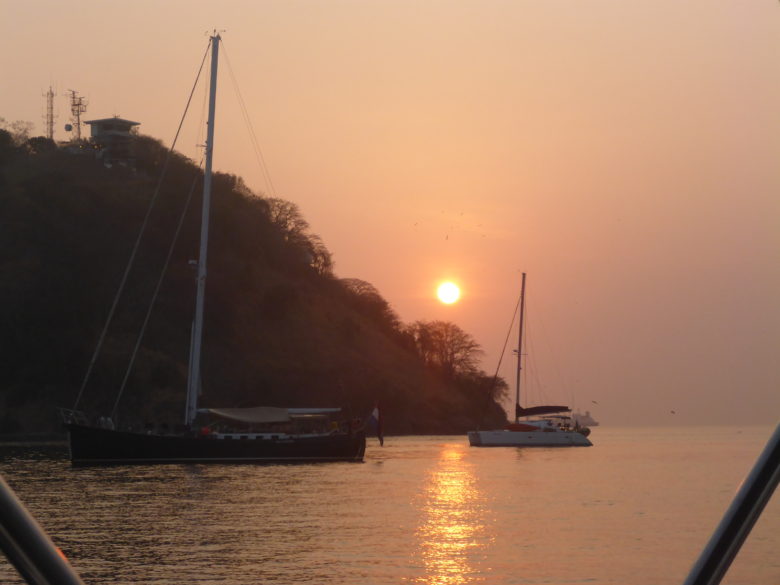Flamenco Marina Panama
The morning after our transit we moved around into the Flamenco Marina and had to say goodbye to our new friends who had been such fun and made the whole experience pleasurable. We are used to being just the two of us on board and having good company was a rare treat. We were unlikely to see Fred and Simon again but as we would be traveling to New Zealand quite soon we will make a point of visiting Jane and Paul at their home on the west coast of South Island.
Zoonie was moored amidst local pristine white sport fishing boats with only two other yachts in the marina. “This looks expensive,” I said. We thought we might stay 7 nights but reduced this to two as the price was $90 per night, around £60. We could not use the electricity as it was 110 volt.

The marina is not geared up for visiting yachts as their communication by email and VHF is patchy and the local shops comprise a duty free emporium and a vast off license, no groceries of any kind within a 30 minute taxi ride. Zoonie was definitely not their target clientele but the welcome was friendly and our money was good enough in the restaurant.
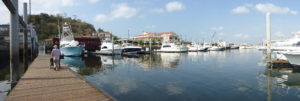
We spent the rest of that day using the Wi-Fi in the nearest restaurant and putting Zoonie back into her regular sea-mode with the forepeak full with bags etc. Early the next morning, before sun-up Rob was busy washing down Zoonie’s decks, while I was scrubbing the oil and rubber off her white fenders and hand-washing a load of canal clothes.
Then we had to brave the local taxis. The drivers wait around the entrance to the mall at the top of the companionway. “Taxi sir, lady,”
“How much to the nearest supermarket?” we ask.
“Fifty dollars,”
“What,” we yelp in unison
“Ok say forty dollars” she tries again.
“How about thirty?” Rob suggests. In the meantime I waved down another taxi and he starts at thirty, but as I turn back to Rob he appears happy with the first taxi, so we clamber in, stunned.
On our way we spot the chart suppliers, Islamorada, so ask if they would collect us the next morning at 10.00am to go there and buy some charts for the Ecuador coast and the French Polynesian islands. We were missing one of the Ecuador coast and four in Polynesia. In a cool attractive room there were hundreds of chart drawers, racks of books and glass cabinets full with watches, sextants etc. We had a wonderful smooch around while our Admiralty charts were being printed off from disc.
Upon our return we fired up Rupert and left the marina heading back to the comfortably free Isla Culebra Anchorage. Our first attempts to anchor failed as it dragged through the soft mud. Later we were visited by the skipper of another Oyster who had seen our efforts and he explained he and his friend had rescued a dragging yacht in that spot whose owners were ashore. “Luckily they had left the key in the engine and the anchor winch on,” he said “So we just re-laid it in a better spot.”
We ended up almost exactly where the anchor had held so well on our first night-time arrival. I had sent lots of photo-emails while we had access to the restaurant Wi-Fi so now I could prepare written blogs that send in an instant through mailasail. It can be a lovely anchorage where we get the best view of vessels of all shapes and sizes entering and leaving the canal. A dredger is operating just a couple of hundred metres from us and works 24/7 with his two ships collecting the liquid sea bottom and taking it off to dump out of the canal.
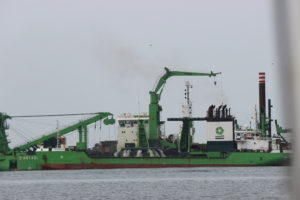
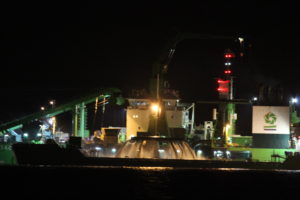
By way of an Aside.
Before the canal was built the isthmus of Panama was used as a transit point both between the Caribbean Sea and Europe and the Pacific and far east and between the southern states of the US and California during the gold rush. All the gold from the Incas was transported by the Spanish up the west coast of South America, into Panama and up the Chagres River to waiting ships in the Caribbean, where it was then often plundered by the British and French on its way to the empty coffers of the Spanish King.
So with the age of railways it was only a matter of time before one was built to make these journeys quicker and easier. The building cost over 8000 lives mostly from diseases like yellow fever, malaria and cholera (as with the canal which devoured 20,000 lives, the greatest peacetime loss of life ever).

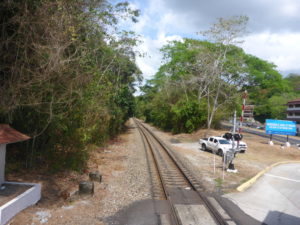
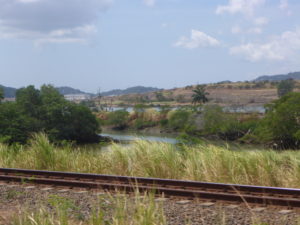
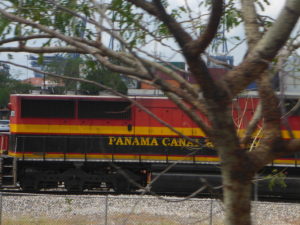
At the time before the canal the Yankee gold prospectors and their wives (dressed in the same garb) in the gold rush were using this route to reach the gold fields in California so the area of rivers and coastline was busy with Americans, Chinese, indigenous Indian tribes, black families, the good and the greedy.
You may remember I mentioned Mary Seacole, the half Jamaican half Scottish lady, who worked in the Crimea at the same time as Florence Nightingale, and was successful on understanding that cholera is a water-borne disease which can be cured.
Well she arrived from Jamaica to help her brother who ran a hotel in the shanty town of Cruces. She soon set up her own British Hotel opposite her brother and later moved to nearby Gorgona and did the same there. She was both a successful doctress, having learned from her mother how to alleviate pain and sometimes cure diseases, and an entrepreneur.
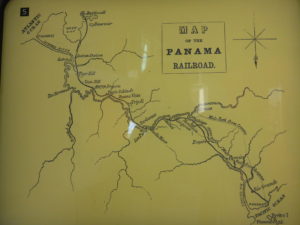
From the map you can see Cruces and Gorgona before the canal was built both served by the all-important mule trails so both towns were affected by the rising waters of Gatun Lake when the canal was under construction. Her book ‘Wonderful Adventures of Mrs Seacole in Many Lands’ was published in 1858 and is well worth a read, I have mine on my Kindle.
A little like the M25, as soon as the canal was finished it was never big enough. As ships grew in size and number so the canal has had to adapt. Dredging is constant, Regis one of our Advisors was an officer on one of them working on the new locks and he aspires to become a captain. Also, we have one working right next to us in the anchorage. Where the canal cuts through rock and shale at the Culebra Cut and the Gaillard Cut widening projects have been completed. The Gaillard Cut is being further widened now from 152 metres to 192 metres on the straight and 222 metres on the curves. This is to allow two wide-beam Panamax vessels to pass each-other at the same time which will increase traffic and reduce transit times.
The current expansion programme is costing $5.25 billion and includes new locks, twice as long as the existing ones. The chambers will be 427 metres long, 55 metres wide and 18.3 metres deep. The project is running over time, but Regis told us the builders are planning to test the locks in May and hand them over to the Panama Canal Authority shortly after if they are working ok. When we used the canal locks the total length of our accompanying ship with us behind or in front could not be more than 730 feet.
Perusing Panama
We plan to take trips on the hop on, hop off red Sightseeing Tour buses on Tuesday and Wednesday, same company operates them all over the world and we used them in Lisbon. We have to give Alex our passports two days before we plan to leave so he can stamp them and organise our exit documents and Zarpe. Then we will be off to the Islas Perlas, The Pacific’s answer to the San Blas, on route to Libertad in Ecuador.
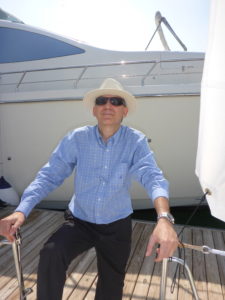
8:54.5N 79:31.6W Isla Culebra Anchorage unofficially renamed Rock and Roll Anchorage, Panama.
We are just under half a mile from the out of sight lower side of the Panama Canal and as such this delightful and interesting spot is rarely still. Between 2.00am and 8.00am all the ships carrying dangerous cargoes make their transit but it is not necessarily their wash that sends the entire anchorage into a rolling frenzy, often it is smaller vessels that move faster that do the disturbing.
All the while the accompanying tugs and pilot vessels ply to and fro through the anchorage and take full advantage of the fact there is no maritime speed limit here. We are used to it now and sometimes continue sleeping despite Zoonie hobby horsing around.
In one of her rare stationary moments an onlooker could see that Zoonie has a noticeable list to starboard. That is because we are using the water in her water-maker tank and it is nearly half empty. We conserve the other tank because when we make water it will level her up and we cannot replace that tankful until we are in port again anyway. If you saw the colour of the water here you would understand why we will not use the water-maker again until the sea is once more a nice blue instead of oily brown.
A few days ago we took a dinghy ride into the private marina, La Playita and were astonished to find you cannot buy a dinghy berth for one day, you have to buy a full week at a cost of $57, another rip off. I can understand why some dinghies are being left on the rocks behind Flamenco despite it being a hazardous climb up slippery rocks to the road.
We started out on the 2 mile walk along the causeway to the Biomuseo, opened recently to celebrate the biodiversity and history of Panama. The walk took us alongside the Smithsonian Institute Centre for land and sea research in the area which is on the tiny Isla Culebra, the outermost of three islands joined to the mainland by the man-made Amador Causeway.
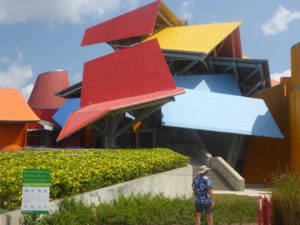
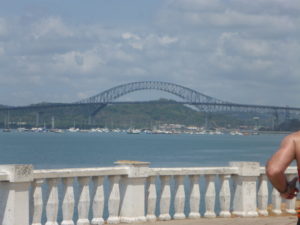
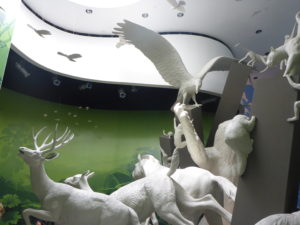
This was built to act as a breakwater to keep the Canal area free of silt and of course is also used for marinas, shops and restaurants. The day was baking hot and as we set off a tall man and his tiny dog jogged merrily past us. We continued our steady pace and came across him sheltering in the shade of a palm tree while his little dog panted frantically. A few moments later he jogged past again and we repeated the scenario. We actually got to the other end just before him; The Hare (and his little dog) and the Tortoise(s) story came to mind.
Frank Gehry, a Canadian architect, (He also designed the Disney Concert Hall and the Guggenheim in Bilbao) designed the museum to resemble the forest jungle, with a many coloured irregular roof like the flowering canopy of the jungle, standing on tall concrete columns like trees, creating delicious cool shady areas outside. Inside was mercifully air-conditioned and enabled us to dry out as we wandered around 40 million years of Panamanian history. I liked the quote that Panama divides two oceans and unites two continents and by some convoluted hypothesis the theory was reached that all mankind originated from here.
Panama’s own population and wealth is growing rapidly and this is pushing up prices for everyone and putting a strain on the infrastructure of roads for example as the volume of traffic grows. The gap between the poor in the slums and the rich is widening causing an increase in the crime rate.
We have Eric Bauhaus’s latest pilot and cruising guide and the marina prices have almost doubled since 2011. His quotes for taxi prices bear no relation to the real world.
Walking back along the causeway we had a pleasant breeze against us and Rob spotted, in the hibiscus hedge next to the Institute a beautiful humming bird and we watched it flit around for some minutes.
The Americans gave up their possession of the ‘canal zone’ in 1999 but their legacy is still enjoyed in the form of restaurants. We ate at Mi Ranchito for lunch which Alex told us was popular with the Americans along with the artificial beach made between the island and causeway close by. It looks decidedly muddy now. The Wi-Fi at the restaurant was slow but useable and we did use it again a couple of times, sitting outside before they opened.
The next morning we again left the dinghy in La Playita and walked around the isthmus to Flamenco resort to catch the City Tour Bus for two days (one and a half days in fact) of exploration. The routes have been shortened because they received complaints about the delays in traffic jams, so we couldn’t get to Panama Viejo, the oldest part of inhabited Panama, which is an interesting area.
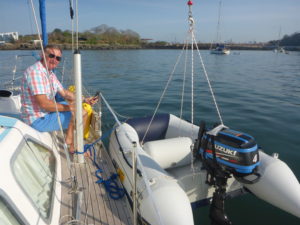
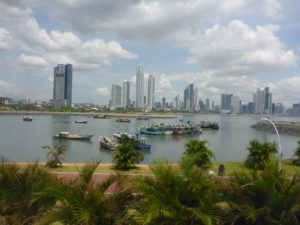
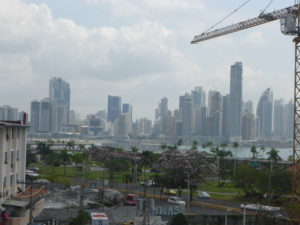
We stayed on the bus for the whole two hour circuit to start with and then got off at Casco Antiguo, the Colonial City. An unrefined version of the old part of Seville. It was much noisier, fifty percent of the buildings are in the process of being restored with pneumatic drills rending the atmosphere and a continual trail of cars and tooting taxis in all the streets that don’t end in the drink.
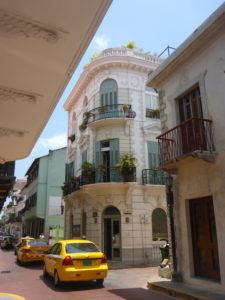
We found the quaintest restaurant at the end of one such street which had lovely views over a sandy beach towards Cinta Costera, a road built on stilts over the water of Panama Bay. The restaurant occupies a demolition area. The owners have simply put in an attractive roof and umbrellas on the terrace, installed some chic tables and chairs and planted fan palms in the earth around the walls. Wi-Fi was good too.
Opposite, Victors Hat shop has been selling Panama hats for decades and it may even have been Victor who popped one on Rob’s head and knowingly tapped it into place. Prices in there ranged from $15 to $250 and poor Rob really did not know how to spot a good Panama hat or how to choose.

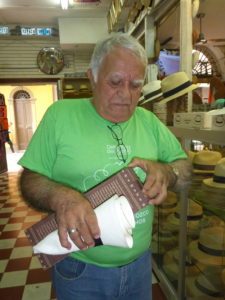
We came away with two, one for Jonty, and the determination to ask our man in Panama, Alex, what he thought.
Making our way back to the bus stop we were thwarted in our attempt to follow the guide map route by armed security guards and police. The President apparently was at a meeting in the beautiful Palacio de Las Garzas o Presidencia de la Republica, or Palacio Bolivar for short.
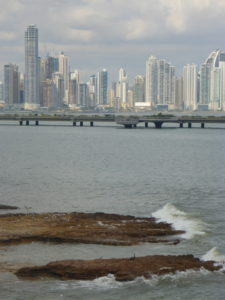
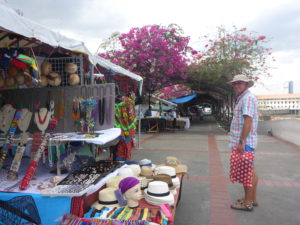
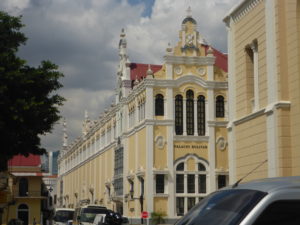
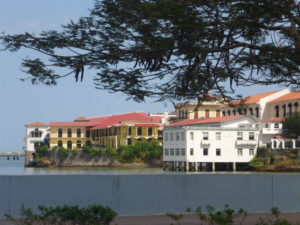
We thought we had got on the last bus to take us back to Flamenco. They don’t go after 2.30 for fear of those complaints I told you about. So we did the whole route again but the bus missed out Flamenco Marina and returned to where we had just got on.
We flagged down the oldest and most decrepit taxi in Panama by far. The rubber hung off the bumper, windscreen smashed eons ago, seats covered in ‘might I catch something?’ loose covers where the old ones were semi-submerged under later additions as bums wore them down. Air-conditioning of the natural variety with wind down windows that fortunately did. The driver had a lovely toothless smile and we got in more from pity and desperation than anything else.
My heart took a dive as he headed from Casco Antiguo straight into the desperately poor area of El Chorrillo to avoid the congestion and from where the inhabitants long to escape and tourists are warned never to venture forth. A famous World Title boxer emerged, a Medusa from the Myre, many years ago to become World Champion winning 109 of his 130 fights. I wondered why the city hadn’t collected the rubbish that overflowed, stinking, from the many skips dotted around the streets. At least the residents had put their rubbish in them.
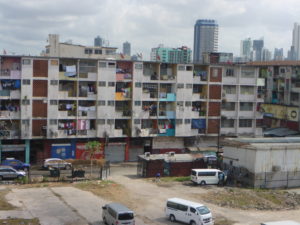
We survived, in fact our driver waved and chatted to some folk, so maybe he hailed from there. Emerging we joined fast moving traffic that soon slowed to rush hour speed. A vehicle on our left wanted to filter in but taximan was having nothing of it and I thought things were going to get nasty. I’m not sure what ‘go away’ is in Spanish but whatever he said it worked and we inched forward with vendors courting death on the lane divides selling drinks and sweets to ease the delay.
Once clear and approaching the isthmus I thought we’d make it, but then a four by four waiting to cross clearly was going to dive in front of us, which he did and caused us to swerve towards the parched grass banks.
As our beaming Chum from Churrillo pulled up in the marina car park a friendly security man pushed the rubber back onto his bumper and we paid the agreed price.
Back on board we laughed and reminisced over the day with a glass of wine.
Our second red bus day was a little more relaxing. We went to the Multicentro Shopping Mall in the centre to buy wheeled bags for our home trip. Rob bought a bag and I bought a set of wheels to tie my present bag to. We wanted head torches for the Machu Picchu hike but the two out of doors shops couldn’t help. We have two on board but despite careful stowage both and numerous torches have died due to humidity in their workings. Could be fumbling our way to the portaloo yet!
We then leapt back onto the bus heading for the Miraflores Locks we had passed through in Zoonie a few days before.
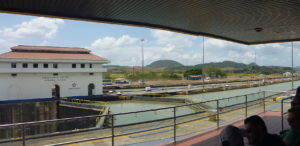
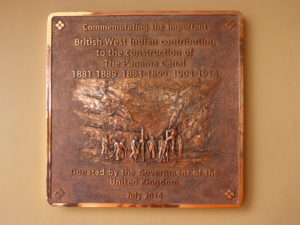
We were subjected to a patronising American film before we wandered through the museum and out onto the arena style seats overlooking the lock. Not a ship in sight and none due until three o’clock, 15 minutes after we had to be back on the last bus to go back to Flamenco.
Disappointed we consoled ourselves with lunch at the marina restaurant where we had eaten once when in the marina. The internet there is good and a further reading about landings in Ecuador convinced us to go to Bahia de Caraquez rather than Libertad.
At Bahia we have to call up a pilot who guides us through the reef into a calm river where Zoonie will be moored between two mooring buoys. Reports from other cruisers are good about the hospitality and leaving boats for trips into the interior or home. Also the manager, Tripp Martin is a friend of John at Shelter Bay so it has to be OK.
I emailed them on their website form.
The next morning we met Panama hatted Alex at La Playita and he took our passports to have them stamped and arrange our clearance docs and Zarpe which is an international notification of clearance between countries. When he returned 40 minutes later I asked about Panama Hats. One can spend what one wants and what one needs the hat for. His work Panama is tougher and harder than his finer weave one for leisure occasions. Neither cost more than $30.
He kindly let us use his phone to call Puerto Amistad at Bahia and confirm they would have a space for us for two months, which is always nice to know before we leave our present location.
We shook firm hands with our charismatic agent who has saved us so much tedious running around in taxis, his expertise and that of his assistants was well worth the $350 fee.
I have already listed eight things Rob and I would like to do here if we ever return. But the time comes to leave and the drain on our financial resources now needs time to recover. So tomorrow we set off for Las Perlas islands, the Pacific’s answer to the San Blas where the satellite photographs of the islands and their reefs will be a godsend.
